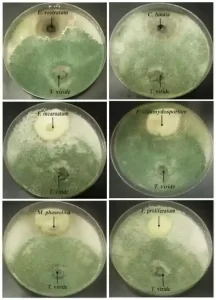Hot Products


TRICHODERMA VIRIDE
Root boost for plants help resist pythium blight
TRICHODERMA VIRIDE,Root boost for plants help resist pythium blight
Trichoderma viride is a helpful fungus that has become increasingly popular in agriculture. It promotes plant growth and controls plant pythium root rot by producing enzymes that can degrade the cell walls of fungi. It has been shown to improve nutrient uptake, enhance root development, and increase plant resistance to stress. Where to buy plant root booster to help your plants grow healthier and stronger, Novobac supplies top quality trichoderma viride powder at reasonable price.
hiddenValue
USE FOR
MODE OF ACTION
TECHNICAL
BENEFIT
INSTRUCTION
DOCS
-
USE FOR
Antagonistic Activity
 The trichoderma fungi inhibits the growth of several plant pathogens due to the production of chitinase, glucanase, protease, cellulase, and lipase.
The trichoderma fungi inhibits the growth of several plant pathogens due to the production of chitinase, glucanase, protease, cellulase, and lipase.(A) E.rostraum
(B) C. lunata
(C) F. incarnatum
(D) F. chlamydosporium
(E) M. phaseolina
(F) F. proliferatum
-
MODE OF ACTION
- Produces various enzymes chitinase, glucanase, protease, cellulase, and lipase that can deteriorate fungi’s cell walls and disrupt their growth. These enzymes break down the structural components of fungal cell walls, making them more vulnerable to other antimicrobial compounds.
- Produces secondary metabolites like peptaibols, gliotoxin, and pyrones that have antifungal properties. These metabolites can effectively inhibit the growth of a wide range of pythium blight by disrupting their cellular processes.
- Competes with other microorganisms for nutrients and resources in the soil. The root boost for plants produces organic acids to lower the soil pH level, which creates an adverse condition for pythium root rot.
- Induces plant defense responses by triggering the expression of genes involved in the synthesis of defense-related compounds. This helps plants to defend themselves against pythium blight and other microbial invaders.
-
TECHNICAL
AVAILABLE SPECIFICATION
Bacteria count : 2x 10^9 cfu/g ,5 x 10^9 cfu/g, 1x 10^10 cfu/g
FORMULATION TYPE
Wettable Powder, 100% soluble
PACKAGING
1 kg or 25 kg per bag
SHELF LIFE AND STORAGE
When properly stored in a cold, dry environment, 24 months.
avoid dampness and bright sunlight.
To avoid activation, use it within 30 days of opening.
Avoid children at all costs.
-
BENEFIT
Benefit
- Promotes plant growth, development, and root boost for plants by enhancing nutrient uptake from the soil.
- Degradation of organic matter and recycling of nutrients in the soil, leading to improved soil health and fertility.
- A sustainable alternative to chemical pesticides, reducing the risk of environmental pollution and human health hazards associated with synthetic chemicals.
- Cost-effective and easy to apply, making it accessible to small-scale farmers and gardeners.
- Improves crop yields, especially in areas where soil-borne diseases are prevalent.
- Contributes to the development of eco-friendly agricultural practices and sustainable food production systems.
-
INSTRUCTION
Application Rate
- Seed Treatment: mix 10-20 g in one liter of water and soak the seeds for 10 minutes before sowing.
- Soil Application: mix 1-2 kg with 50-100 kg of well-decomposed organic manure and apply it uniformly in the field. You can also mix 1-2 g in one liter of water and drench the soil around the root zone.
- Foliar Spray: Add 10 to 20 g to a litre of water and spray it uniformly on the leaves of the plants.
Advantages of using Trichoderma viride instead of chemical fungicides
- Safety: a natural biological agent that is not harmful to humans, animals, or the environment. Unlike chemical fungicides, it does not leave any toxic residues on crops or in the soil.
- Sustainability: a sustainable alternative to chemical fungicides as it is an organism that can be easily mass-produced and applied to crops.
- Versatility: can be used on a wide range of crops against a broad spectrum of plant pathogens, making it a versatile solution for farmers and growers.
- Resilience: effective even under low temperatures, drought, and high salinity, making it suitable for use in different regions and climates.
- Cost-effectiveness: long-term benefits of trichoderma for plants make it a cost-effective solution for farmers and growers.
How long does Trichoderma viride remain effective in the soil after application?
Trichoderma for plants can survive in the soil for several weeks to months after application. To maintain the effectiveness of trichoderma fungi powder, it is recommended:
- Apply the product in the conditions: warm (20-30°C) and moist soil conditions (5.0-8.0 pH ) to improve pythium root rot.
- Use a suitable carrier: peat moss or vermiculite, which provides a favorable environment for the fungus to grow and colonize plant roots.
- Store the product correctly: in a cool, dry place, away from direct sunlight.
- Apply regularly: maintain a high population of the fungus in the soil of pythium blight.
- Combination with other control measures: crop rotation and sanitation to maximize its effectiveness and decrease resistant pathogen populations.
-
DOCS


CONTACT US

Office 38/1502, No 660,Hanguang Rt., Changsha City, Hunan, China






